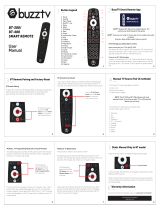
3
Network
3.1
Wireless network
What you need
To connect the TV wirelessly to the Internet, you need a
wireless router. Use a high-speed (broadband) connection to
the Internet.
Network devices
The TV can connect to other devices in your wireless network,
like your computer or smartphone. You can use a computer
with Microsoft Windows or Apple OS X.
File sharing
On this TV, you can open photos, music and videos stored on
your computer. Use a recent version of media server software
like Philips MediaManager*, Windows Media Player 11,
Twonky™ or similar.
Install the media server software on your computer and set it up
to share your media files with the TV. Read the manual of the
media server software for more information. This software must
be running on your computer to view or play your files on TV.
* You can download the Philips MediaManager software from
the Philips support site www.philips.com/support
Make the connection
Follow steps 1 to 5.
Step 1 - Make sure that the router of your wireless network is
switched on.
Step 2 - Press
and select Setup and press OK.
Step 3 - Select Connect to network and press OK.
Step 4 - Select Connect and press OK.
Step 5 - Select Wireless and press OK.
Step 6 - Select Scan to scan for your wireless network. If you
have a router with WPS (Wi-Fi Protected Setup), you can select
WPS. Select your choice and press OK.
Scan
Select Scan to scan for your wireless network (your
wireless router). The TV might find several wireless
networks in your proximity.
WPS
If your router has WPS, you can directly connect to the
router without scanning. Go to the router, press the
WPS button and return to the TV within 2 minutes.
Then press Connect to make the connection.
If you have devices in your wireless network that use the
WEP security encryption system, you cannot use WPS.
If you must use the WPS PIN code to connect, select
Scan instead of WPS.
Step 7 - In the list of networks found, select your wireless
network and press OK.
If your network is not in the list because the network name is
hidden (you switched off the SSID broadcast of the router),
select Manual entry to enter the network name yourself.
Step 8 - Depending on the type of router, you can now enter
your encryption key (WEP, WPA or WPA2). If you entered the
encryption key for this network before, you can select Next to
make the connection immediately.
If your router supports WPS or WPS PIN, you select WPS,
WPS PIN or Standard. Select your choice and press OK.
Standard
Select Standard to enter the encryption key (password,
passphrase or security key) manually.You can use the
keyboard on the RC to enter the encryption key. Once
you have entered the key, press Connect.
WPS PIN
To make a secured WPS connection with a PIN code,
select WPS PIN and press OK. Write down the 8-digit
PIN code shown and enter it in the router software on
your PC. Return to the TV and press Connect. Consult
the router manual on where to enter the PIN code in
the router software.
Step 9 - A message will be shown when the connection is
successful.
Network configuration
If the connection fails, you can check the DHCP setting of the
router. DHCP should be set to On.
Alternatively, if you are an advanced user and want to install
your network with Static IP addressing, set the TV to Static IP.
To set the TV to Static IP, press
and select Setup and press
OK. Select Network settings > Network settings > Network
configuration > Static IP. With Static IP selected in the menu,
you can set the IP address and other necessary settings in Static
IP configuration in the same menu.
9






















